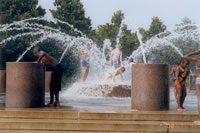Interactive Fountains / Wet Decks / Spray Pads
A new addition to recreational water attractions has been the interactive fountain (may also be called wet deck, splash pad, spray pad, or spray parks). Although there is no standing water in these attractions, it is still possible for the water to become contaminated resulting in outbreaks of illness.

During the summer of 2005 an outbreak of cryptosporidiosis occurred at Seneca Lake State Park in New York. Over 1,700 people may have been infected with 425 laboratory confirmed cases of cryptosporidiosis and 1,374 probable cases identified1. Cryptosporidium was traced to the water tanks that supplied the 11,000 square foot wet deck (spraypark). In response, New York passed emergency public health regulations to govern the design and sanitation of such attractions statewide.
A 1999 outbreak of diarrheal illness affected 44% of patrons (an estimated 4,800 people) who visited a new local wet deck in a beachside park. When officials from the health department inspected the wet deck, they found that the water drained from the play area (no standing water) into an underground reservoir for recirculation. What was the problem? Inadequate chlorination and no filtration system. The chlorine tablet erosion feeder hadn’t been filled for weeks and the designers didn’t include a filtration system. Find the MMWR article at: www.cdc.gov/mmwr/preview/mmwrhtml/mm4925a3.htm
People may not realize that the spray water will rinse any contamination (diarrhea, vomit, dirt) down into the water holding area. Because these wet decks are a recent addition to the recreational water fun scene, health departments may not have specific requirements for how the water is treated.
It pays to be proactive by building wet decks like any other water attraction is built. They should include appropriate disinfection and filtration systems even if it is not written into the local or state pool code. Addition of supplementary disinfection like ultraviolet light or ozone, should be considered and is now required in New York state. Health departments should also ensure that pool codes are updated to include water features that do not have standing water.
- Shaffzin JK, Keithly J, Johnson D, Sackett D, Hoefer D, Hoyt L, Lurie M, Teal A, Rosen B, Tavakoli N, St. George K, Braun-Howland E, Wallace B . Large Outbreak of Cryptosporidiosis Associated with a Recreational Water Spraypark—New York 2005. 55th Annual Epidemic Intelligence Service Conference, 2006.
Page last modified: April 12, 2007
